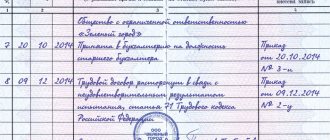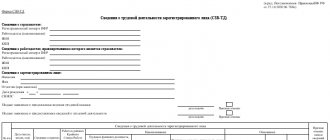Who can be fired by transfer?
Due to a transfer to another employer (clause 5, part 1, article 77 of the Labor Code of the Russian Federation), you can part with any employee with his consent, expressed in writing or his written request. On this basis, it is possible to terminate an employment agreement with a pregnant employee, an employee with young children, or someone who is on vacation or sick leave. This follows from clause 5, part 1, art. 77, part 2 art. 72.1, part 6 art. 81, part 1, 4 art. 261 Labor Code of the Russian Federation. Termination of an employment contract in a similar format can be initiated:
- employee;
- employer (current);
- employer (future).
General procedure for dismissal due to transfer
The procedure for dismissal under the terms of transfer to another employer consists of several steps.
| Step No. | Procedure for dismissal by transfer | Decoding |
| 1 | New employer: developing a letter inviting you to find a job with a new translation employer | The transfer letter consists of the following information:
|
| 2 | Current employer: developing a response letter on behalf of the current employer | The letter includes information about consent to the employee's transfer. Not required. Consent to the transfer can also be expressed on the letterhead from paragraph 1. |
| 3 | Employee: writing a letter of resignation due to transfer | The resignation letter for transfer includes information:
In the text of the application, you should make a reference to the invitation received from the new employer and attach a copy of it. |
| 4 | Current employer: issuance of a dismissal order by way of transfer | An order for dismissal based on transfer can be issued using standard forms T-8 or T-8a. The administrative document for dismissal in accordance with the established procedure must include:
|
| 5 | Current employer: entering information into the work book in the manner prescribed by the legislator, issuing it | The wording of the entry is made with reference to clause 5, part 1, art. 77 Labor Code of the Russian Federation. |
| 6 | Current employer: settlement with employee | Produced for the period worked and unused vacation days. |
Transfer at the initiative of employers
Employers can agree on the transfer of a specialist by agreement in several cases:
- their companies are affiliated;
- The companies are in partnership.
Whatever reasons motivate managers, transfer through dismissal is carried out according to the following algorithm.
The future manager sends a request to the current employer asking for assistance in the employee's transition. There is no legally established form for such an appeal, so you should rely on business customs. The request should indicate:
- FULL NAME. and employee position;
- expected date of conclusion of the contract;
- proposed position, department, salary (it is not necessary to hide it).
Having received a request, the current manager discusses the received proposal with the employee.
If an employee agrees to change jobs, he must write a letter of resignation in connection with a move to another organization and attach a letter of offer to it.
The current employer sends a confirmation letter to the organization where the employee is transferring and begins the dismissal procedure. This situation is more like a dismissal procedure by agreement of the parties.
Dismissal is formalized according to standard rules:
- a corresponding order is issued indicating the reason (clause 5 of Article 77 of the Labor Code of the Russian Federation);
- a note about the transfer to another company is placed on the employee’s personal card (form T-2) and an entry is made in his work book (“Dismissed due to transfer with the consent of the employee,” reference is made to paragraph 5 of part 1 of Article 77 of the Labor Code of the Russian Federation);
- on the last day of work, the employee receives full payment (salary for days worked, compensation for unused vacation and other payments provided for in the collective or employment agreement).
Employment with a new employer also follows the general procedure, with the exception of several features:
- the invited specialist cannot be denied employment;
- he cannot be placed on probation.
Please note that a distinction should be made between a transfer to another employer and a relocation. In the second case, the employee’s consent is not required, since when moving, the terms and parties of the employment contract remain unchanged - the employee remains in the same company.
A complete guide to the dismissal procedure from ConsultantPlus
1. How to draw up an agreement to terminate an employment contract
By agreement of the parties, the employment contract can be terminated at any time within the period determined by the parties. This follows from the totality of the provisions of Art. 78 of the Labor Code of the Russian Federation, clause 20 of the Resolution of the Plenum of the Supreme Court of the Russian Federation dated March 17, 2004 N 2. The initiator of termination of the contract on this basis can be either the employee or the employer.
Read more
If the initiator is another organization
If a new employer applies for a transfer, he sends a request to the organization where the employee he is interested in works to consider the possibility of transferring him.
A letter proposing to terminate the contract by way of transfer on behalf of the new employer is generated in any form; there is no legally established template. Usually the document is drawn up on the letterhead of the initiating institution. The letter contains the following information:
- last name, first name, patronymic and position of the specialist invited to work;
- the name of the institution where the person is invited;
- text with a translation proposal;
- request to review the transfer letter within a limited period, the desired format for receiving a response;
- date of expected hiring;
- vacancy for which a subordinate is invited;
- signature of a person with appropriate authority (usually a manager).
The employing organization, having reviewed the letter, must respond with consent or refusal, as evidenced by the manager’s visa. The request is accompanied by the employee’s signature indicating agreement (or disagreement) with the proposed position.
If the decision is positive, the employer sends a response letter to the initiating party, which confirms both his and the employee’s consent.
A letter of consent to dismiss an employee by way of transfer is drawn up in any form; there is no legally established template. If the current employer does not object to dismissal by transfer, the letter, in addition to consent, should indicate the date of dismissal. Taking into account the content of Part 2 of Art. 72.1 of the Labor Code of the Russian Federation, before drawing up a letter of dismissal, it is necessary to obtain the employee’s consent (request) for the transfer. In addition, you can obtain a person’s consent to process and transfer his personal data to a third party (in order to avoid liability under Part 2 of Article 13.11 of the Code of Administrative Offenses of the Russian Federation).
Dismissal of an employee by his consent (the initiative comes from the manager)
This version of the transfer procedure is similar to the previous one, so we will not repeat ourselves, but will talk about the differences and features of the transfer on the initiative of the manager.
- The heads of enterprises agree among themselves that one fires the employee, and the second hires. This can be confirmed by a letter of invitation (as in the first option).
- After this, the employee himself must be familiarized with the upcoming transfer. He must be told in writing about the position he will hold, the working conditions, and the salary amount. If an employee does not agree to a transfer, then no one can force him to change his job.
If the employee agrees to the transfer, he can write “I agree to the transfer” on the written notice, adding a date and signature. A tripartite agreement is drawn up.
- After which the receiving party receives a confirmation letter.
- At an enterprise where an employee is fired, the manager issues a dismissal order, which states that the dismissal occurs with the consent of the employee. It is also necessary to refer to Article 77 of the Labor Code of the Russian Federation.
- After which, appropriate entries are made in the work book and personal card, which also indicate that the dismissal is carried out with the consent of the employee . A sample record of dismissal in the order of transfer in the work book was discussed earlier in the first version.
- All records and orders must be presented to the employee against his signature.
- A settlement is made with the payment of all compensation, after which a work book and a certificate of income for 2 years are issued.
Also read: Dismissal of employment by agreement of the parties.
Is it necessary to write a letter of resignation in the order of transfer?
Dismissal upon transfer to another employer is regulated by clause 5 of part 1 of article 77 of the Labor Code of the Russian Federation. Its feature is a mandatory agreement between all parties involved in the process: the new and previous employers and the employee. The wording of personnel documents must specify exactly how the transfer through dismissal is carried out: at the request of the employee or with his consent. If a negative decision is made, the subordinate retains the right to terminate the employment contract at his own request.
Employment contract with an employee hired by transfer
EMPLOYMENT CONTRACT with an employee hired as a transfer
___________________ “___”_________ ____ city ________________________________, hereinafter referred to as “Employer” (name of organization) (“Organization”), represented by _________________________, acting__ on the basis of (position, full name) __________________________, on the one hand , and ___________________________, (charter, regulations, etc.) (full name) hereinafter referred to as____ “Employee”, on the other hand, have entered into this agreement as follows.
SUBJECT OF THE AGREEMENT
1.1.
The Employer provides the Employee, and the Employee undertakes to perform work in the position of _______________ in the department of _______________. 1.2. The Employee is accepted into the Organization by transfer from _______________ (name of the organization from which the Employee arrived) on the basis of _______________ 1.
1.3. The work under this agreement is the main one for the Employee.
1.4. The Employee’s place of work is __________, located at the address: _______________.
1.5. The Employee’s work under this agreement is carried out under normal conditions. The Employee’s labor duties are not related to performing heavy work, work in areas with special climatic conditions, work with harmful, dangerous and other special working conditions.
CONTRACT TIME
2.1. The employee must begin performing his job duties from “___”________ ____.
2.2. This agreement is concluded for an indefinite period and can be terminated on the grounds established by the labor legislation of the Russian Federation.
CONDITIONS OF PAYMENT FOR EMPLOYEES
3.1. For the performance of labor duties, the Employee is paid a salary in the amount of _____ (_______________) rubles per month.
3.2. The employer establishes incentives and compensation payments (additional payments, allowances, bonuses, etc.). The amounts and conditions of such payments are determined in the Regulations on bonus payments to employees “__________”, which the Employee was familiarized with when signing this agreement.
3.3. If the Employee, with his written consent, performs, along with his main work, additional work in another position or performs the duties of a temporarily absent employee without being released from his main job, the Employee is paid an additional payment in the amount established by an additional agreement of the parties to the employment contract.
3.4. Overtime work is paid for the first two hours of work at time and a half, for subsequent hours - at double rate. At the Employee's request, overtime work, instead of increased pay, may be compensated by providing additional rest time, but not less than the time worked overtime.
3.5. Work on a day off or a non-working holiday is paid in the amount of a single part of the official salary per day or hour of work in excess of the official salary, if work on a day off or a non-working holiday was carried out within the monthly standard working time, and in the amount of a double part of the official salary per day or hour work in excess of the official salary, if the work was performed in excess of the monthly working hours. At the request of an Employee who worked on a day off or a non-working holiday, he may be given another day of rest. In this case, work on a weekend or a non-working holiday is paid in a single amount, and a day of rest is not subject to payment.
3.6. Downtime caused by the Employer is paid in the amount of two-thirds of the Employee’s average salary.
Downtime due to reasons beyond the control of the Employer and Employee is paid in the amount of two-thirds of the official salary, calculated in proportion to downtime.
Downtime caused by the Employee is not paid.
3.7. The Employee's wages are paid by issuing cash at the Employer's cash desk (option: by transfer to the Employee's bank account) every half month on the day established by the Internal Labor Regulations.
3.8. Deductions may be made from the Employee's salary in cases provided for by the legislation of the Russian Federation.
REGIME OF WORKING TIME AND REST TIME 2. VACATION
4.1. The following working hours are established for the employee: ______________________________ 2.
Weekends: _____________________________________ 2.
4.2. Start time: _________________________________ 2.
Finish time: __________________________ 2.
4.3. During the working day, the Employee is given a break for rest and food from _____ hour. up to _____ hour, which is not included during working hours 2.
4.4. The employee is granted annual paid leave of _____ (at least 28) calendar days.
Vacation is granted to the Employee at any time of the working year in accordance with the vacation schedule.
4.5. For family reasons and other valid reasons, the Employee, on the basis of his written application, may be granted leave without pay for the duration established by the labor legislation of the Russian Federation and the Internal Labor Regulations “__________”.
RIGHTS AND OBLIGATIONS OF AN EMPLOYEE
5.1. The employee is obliged:
5.1.1. Conscientiously perform your job duties as defined in the job description, which is Appendix No. _____ to this agreement.
5.1.2. Comply with the Internal Labor Regulations “__________” and other local regulations of the Employer.
5.1.3. Maintain labor discipline.
5.1.4. Comply with labor standards if they are established by the Employer.
5.1.5. Comply with labor protection and occupational safety requirements.
5.1.6. Treat the property of the Employer and other employees with care.
5.1.7. Immediately inform the Employer or immediate supervisor about the occurrence of a situation that poses a threat to the life and health of people, the safety of the Employer’s property.
5.1.8. Do not give interviews, conduct meetings or negotiations regarding the activities of the Employer without prior permission from management.
5.1.9. Do not disclose information that constitutes a trade secret of the Employer. Information that is a trade secret of the Employer is defined in the Regulations on Trade Secrets “__________”.
5.1.10. By order of the Employer, go on business trips in Russia and abroad.
5.2. The employee has the right to:
5.2.1. Providing him with the work stipulated by this agreement.
5.2.2. Timely and full payment of wages in accordance with your qualifications, complexity of work, quantity and quality of work performed.
5.2.3. Rest, including paid annual leave, weekly days off, non-working holidays.
5.2.4. Compulsory social insurance in cases provided for by federal laws.
5.2.5. Other rights established by the current legislation of the Russian Federation.
RIGHTS AND OBLIGATIONS OF AN EMPLOYER
6.1. The employer is obliged:
6.1.1. Comply with laws and other regulations, local regulations, and the terms of this agreement.
6.1.2. Provide the Employee with work stipulated by this agreement.
6.1.3. Provide the Employee with equipment, technical documentation and other means necessary to perform his job duties.
6.1.4. Pay the wages due to the Employee on time and in full, as well as make other payments within the time limits established by the Internal Labor Regulations.
6.1.5. Provide for the Employee’s everyday needs related to the performance of his job duties.
6.1.6. Carry out compulsory social insurance for the Employee in the manner established by federal laws.
6.1.7. Introduce the Employee, against signature, to the adopted local regulations directly related to his work activity.
6.1.8. Perform other duties established by the current legislation of the Russian Federation.
6.2. The employer has the right:
6.2.1. Encourage the Employee for conscientious, effective work.
6.2.2. Require the Employee to fulfill job duties specified in the job description, to take care of the property of the Employer and other employees, and to comply with the internal labor regulations.
6.2.3. Bring the Employee to disciplinary and financial liability in the manner established by the current legislation of the Russian Federation.
6.2.4. Adopt local regulations.
6.2.5. Conduct certification of the Employee in accordance with the Certification Regulations in order to identify the real level of professional competence of the Employee.
6.2.6. Conduct an assessment of the Employee’s performance in accordance with the Regulations on Labor Performance Assessment.
6.2.7. With the consent of the Employee, involve him in the performance of certain tasks that are not part of the Employee’s job responsibilities.
6.2.8. With the consent of the Employee, involve him in performing additional work in a different or the same profession (position) for an additional fee.
6.2.9. Exercise other rights provided for by the current legislation of the Russian Federation and local regulations.
EMPLOYEE SOCIAL INSURANCE
7.1. The employee is subject to social insurance in the manner and under the conditions established by the current legislation of the Russian Federation.
GUARANTEES AND COMPENSATIONS
8.1. During the period of validity of this agreement, the Employee is subject to all guarantees and compensations provided for by the labor legislation of the Russian Federation, local acts of the Employer and this agreement.
RESPONSIBILITY OF THE PARTIES
9.1. A party to a contract guilty of violating labor legislation and other regulatory legal acts containing labor law norms is liable in cases and in the manner established by the Labor Code of the Russian Federation and other federal laws.
9.2. The financial liability of a party to a contract arises for direct actual damage caused by it to the other party to the contract as a result of its culpable unlawful behavior. Direct actual damage is understood as a real decrease in the Employer’s available property or deterioration in the condition of said property (including property of third parties located by the Employer, if the Employer is responsible for the safety of this property), as well as the need for the Employer to make costs or excess payments for the acquisition, restoration of property or compensation for damage caused by the Employee to third parties.
9.3. In cases provided for by law, the Employer is obliged to compensate the Employee for moral damage caused by unlawful actions and (or) inaction of the Employer.
9.4. Each party is required to prove the amount of damage caused.
TERMINATION OF THE AGREEMENT
10.1. The grounds for termination of this employment contract are:
10.1.1. Agreement of the parties.
10.1.2. Termination of an employment contract at the initiative of the Employee. In this case, the Employee is obliged to notify the Employer no later than two weeks before the expected date of termination of this agreement. The specified period begins the next day after the Employer receives the Employee’s resignation letter.
10.1.3. Termination of an employment contract at the initiative of the Employer in cases established by law.
10.1.4. Other grounds provided for by the labor legislation of the Russian Federation.
10.2. The day of termination of the employment contract in all cases is the Employee’s last day of work, with the exception of cases where the Employee did not actually work, but retained his place of work (position).
10.3. The Employer has the right to decide to make a compensation payment to the Employee in the amount of ________ in the case of ______________.
FINAL PROVISIONS
11.1. The terms of this employment contract are confidential and are not subject to disclosure.
11.2. The terms of this employment contract are legally binding on the parties from the moment it is signed by the parties. All changes and additions to this employment contract are formalized by a bilateral written agreement.
11.3. Disputes between the parties arising during the execution of an employment contract are considered in the manner established by the current legislation of the Russian Federation.
11.4. In all other respects that are not provided for in this employment contract, the parties are guided by the legislation of the Russian Federation governing labor relations.
11.5. The agreement is drawn up in two copies having equal legal force, one of which is kept by the Employer and the other by the Employee.
11.6. Before signing the employment contract, the Employee is familiar with the following documents:
— _______________________________;
— _______________________________;
— _______________________________.
DETAILS OF THE PARTIES
Employer: __________________________________________________________ address: ___________________________________________________________________, INN ___________________________________, checkpoint ___________________________________, r/s ___________________________________ in ________________________________, BIC ___________________________________.
Employee: ____________________________________________________________ passport: series _______ number ___________, issued ___________________________ "___"_________ ____, department code _____________, registered at the address: ______________________________________________________________. SIGNATURES OF THE PARTIES: Employer: Employee: ____________/_______________ _____________________________ M.P. A copy was received and signed by the Employee “___”________ ___ Employee’s signature: ____________________ 1 The transfer of an Employee from one employer to another can be carried out on the basis of a tripartite agreement and a written application of the Employee or on the basis of an agreement between the current and future employers. The Employee's written consent to the transfer is required (Part 2 of Article 72.1 of the Labor Code of the Russian Federation).
2 These provisions are included if for a given Employee the working time and rest time regime differs from the general rules in force for this Employer.
If the initiator is an employee
The solution to the problem of transferring a specialist is not always given to organizations painlessly and without conflicts. Especially when it comes to a highly qualified professional. Therefore, the employees themselves are often involved in resolving all issues. You need to write a letter of resignation, accompanied by a job offer. After considering the request, the manager endorses the decision.
The employee must submit an appeal related to the desire to resign and transfer to a new job in writing (Part 2 of Article 72.1 of the Labor Code of the Russian Federation). The format is arbitrary, there is no template defined by the legislator.
After receiving an application, the employer should pay attention to the following factors:
- availability of full name and employee positions;
- a request to dismiss (consent to dismissal) under clause 5, part 1, art. 77 Labor Code of the Russian Federation;
- date of transfer to another employer.
Tripartite Agreement
The employee, employer and future employer can enter into a tripartite severance agreement for the transfer when no one objects. The execution of such a document on dismissal is not provided for by law. But it is widely used in business, as it significantly reduces the volume of paperwork: all conditions are included in one agreement, which speeds up the procedure.
The agreement is formed arbitrarily, since there is no legally established version of the form. The document includes:
- information about the parties - names of current and future employers, full name. employee;
- provisions on an agreement to dismiss a person by transfer and hire him to a new position (the day of dismissal, hiring, future position is prescribed);
- other conditions, for example, regarding vacations.
Issued in 3 copies (one for each). Each copy must be signed by all three participants.
Making an order
The procedure takes place as usual. The main thing is to correctly fill out, issue the necessary documents and make timely payments.
As a general rule, you can draw up an administrative document on dismissal using forms T-8, T-8a. It is acceptable to use your own order template.
The line containing the basis for termination of the agreement must be correctly reflected, using clause 5, part 1, art. 77 Labor Code of the Russian Federation.
| Dismissal format | Formulation |
| At the employee's request | Transfer of an employee at his request to work for another employer, clause 5 of part 1 of article 77 of the Labor Code of the Russian Federation |
| With the employee's consent | Transfer of an employee, with his consent, to work for another employer, clause 5 of part 1 of article 77 of the Labor Code of the Russian Federation |
When drawing up a dismissal order (clause 5, part 1, article 77 of the Labor Code of the Russian Federation), we must indicate exactly how the process is formalized: with the consent of the subordinate or at his request. The basis must refer either to the letter of request, indicating the date and originating document number, or to the employee’s application, as well as an invitation to work. The basis for issuing a dismissal order are all the papers that were used during the development process:
- letter of offer from a new employer;
- response letter with consent from the current one;
- employee statement;
- tripartite agreement.
The order must be presented to the employee against his signature. If this is not possible or if you refuse, you must make a note (Part 2 of Article 84.1 of the Labor Code of the Russian Federation).
How to make the transition correctly: rules and stages
Dismissal by transfer can be carried out either at the initiative of the employer or at the request of the employee himself. In the first case, the following algorithm of actions is performed:
- The head of the company (enterprise) where the employee will be transferred sends a separate letter of request to the relevant employer. This document specifies:
- Full name and current position of the person being dismissed;
- preliminary date for concluding a new employment contract (agreement);
- department name;
- future position and salary.
- After receiving the request letter, the head of the enterprise (firm) conducts official negotiations with the relevant specialist (employee).
- In case of written consent with the proposed procedure for canceling the employment contract, the employee fills out a letter of resignation.
- The head of the company (enterprise) sends a corresponding letter of application to another organization with a proposal to transfer a specific employee.
- A dismissal order is issued. Moreover, this document must include a reference to clause 5, part 1, art. 77 Labor Code of the Russian Federation.
- The employee’s personal card is filled out (according to form T-2)
- The following entry is made in the employment record of the dismissed person: “Dismissed by way of transfer to another organization with the consent of the employee, paragraph 5 of part one of Article 77 of the Labor Code of the Russian Federation.”
- On the last working day, the final settlement with the dismissed person is made. In such a situation, he is paid a salary for the last month (days) worked, vacation pay, sick leave and other payments established by the employment contract (agreement).
Sample entry in a work book.
Hiring for a new job also takes place in accordance with the generally established procedure. Moreover, in such a situation, the head of the organization cannot refuse to employ a person who has already been fired. In addition, he is prohibited from leaving such an employee for a probationary period (Article 70 of the Labor Code of the Russian Federation).
Transfer to another organization at the initiative of an employee is carried out as follows:
- The employee receives a letter of request from another organization and draws up a corresponding resignation letter. He then forwards these documents to his employer.
- The employer negotiates with the head of the enterprise (firm) where the relevant employee of the organization wants to transfer.
- The personal card of the dismissed person is filled out.
- A new entry is made in the employee’s employment contract (“The employment contract was terminated due to the transfer of the employee at his request to another employer, paragraph 5 of part one of Article 77 of the Labor Code of the Russian Federation”).
- On the last day of work, the final payment is made to the dismissed person.
In case of disagreement with the transfer, the employee has the right to file a claim in court. This can be done within a month from the date of detection of a violation of labor rights (Article 392 of the Labor Code of the Russian Federation). The court will be able to cancel the dismissal and reinstate the employee.
At the same time, you can visit the local labor inspectorate . The inspector can conduct an inspection, issue an order to the employer on what actions need to be taken, and bring him to administrative responsibility.
Registration of a work book
The work book contains a record of the termination of the employment relationship and a link to the relevant article of the Labor Code of the Russian Federation. It is specified on whose initiative the translation is being carried out.
The receiving party enters the name of the organization, and then, under the new serial number, makes a record of the reception of the employee.
The registration is made according to the usual rules for registration. Column 3 includes information about the grounds for dismissal under clause 5, part 1, art. 77 Labor Code of the Russian Federation. All information is entered without abbreviations and certified by the signature of the responsible person and the seal of the company.
Issuing a transfer order
The procedure for moving to another organization is enshrined in Chapter 13 of the Labor Code of the Russian Federation. According to current legislation, the procedure for registering dismissal due to transfer to another organization in 2022 has not changed. First, the employee receives an invitation, submits an application to the employer, and the contract is terminated. The new employer has the right to express the initiative for the transfer by submitting a request to the employee’s current management. In this case, the employee’s consent must be obtained in writing. This procedure is practiced much less frequently.
The manager issues a dismissal order drawn up in Form No. T-8. The following documents are indicated as the basis for leaving:
- invitation to a future employer;
- consent of the current employer;
- statement or consent of the worker.
The person leaving is introduced to the order and signed. On the day of departure, the payment is transferred to him and the book is returned with an entry about the termination of the contract made in it.
Terms and guarantees
Dismissal by transfer to another organization has its own legal consequences and provides the employee with guarantees:
- If an employee is dismissed after moving to another organization, the new employer loses the right to refuse to hire such an employee and, on the contrary, is obliged to hire him within a month from the date of dismissal (Article 64 of the Labor Code of the Russian Federation).
- If the employee is accepted by transfer, then no test is established (Part 4 of Article 70 of the Labor Code of the Russian Federation), since it is considered that the invited specialist is highly qualified and meets the requirements for his position.
Advantages of dismissal by transfer
Obtaining a new job as a result of a transfer to another organization is more beneficial to the employee due to the fact that:
- if there is a written invitation, the citizen is guaranteed to get a job in a new company within 30 days after leaving his previous place, but it should be noted that the period is not extended during the illness of the invitee, since the Labor Code of the Russian Federation does not indicate actions for such a reason;
- the new place of employment does not provide for the use of a trial period in relation to a new specialist (Article 70 of the Labor Code of the Russian Federation);
- by agreement with the management, the 2-week period of compulsory service at the old place can be canceled;
- expenses for relocation of a citizen and his family members, as well as transportation of property, are reimbursed if the new employer is located in a different area;
- Some categories of employees may be granted leave at a new place for 6 months previously worked (those going on maternity leave, immediately after leaving maternity leave, persons under 18 years of age).
For an organization, the transition of a citizen to a new place can be beneficial in a situation with staff reduction or liquidation of an enterprise - you will not have to pay severance pay.
Advantages and disadvantages
For the employee, the positive aspects of the process include:
- guaranteed employment (the employer has no right to refuse employment, Article 64 of the Labor Code of the Russian Federation);
- absence of a trial period of 3 months (part 4 of article 70 of the Labor Code of the Russian Federation).
For the employer, there is no need to pay severance pay if a person is laid off, that is, an opportunity to save the budget.
The disadvantages of the dismissal process by transfer for an employee are:
- inability to return a letter of resignation if an agreement is drawn up. If a person has changed his mind and does not want to leave his employer, the problem will have to be resolved in an individual conversation with the signatories;
- inability to save leave during the transition;
- compensation is paid at the previous place; at the new place you can apply for leave after six months - Art. 122 Labor Code of the Russian Federation.
Refusal to hire from new employer
Article 64 of the Labor Code of the Russian Federation gives the employee a guarantee of employment. The potential employer who sent the invitation does not have the right to change the decision and refuse to hire the employee.
An invitation to move to a new place and a person’s written consent will become documents that guarantee employment. If the new employer still refuses to hire, the employee has the right to file a complaint with the labor inspectorate or send a statement of claim to the court. If the decision is positive for the employee, the court will establish the obligation for the employer to conclude an employment agreement from the date following the date of dismissal from the previous place.





